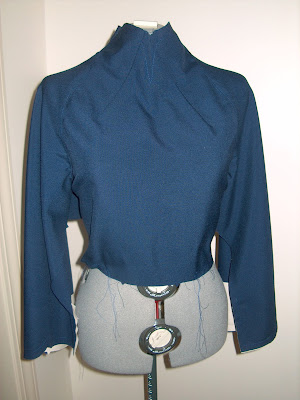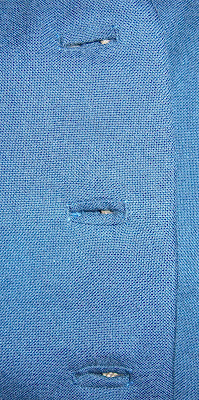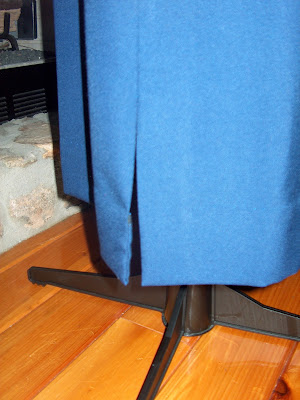Mrs. Franklin D. Roosevelt
In 1933 Eleanor Roosevelt's book It's Up to the Women called on American women to help bring the country through its economic crisis. The Great Depression was the gravest that the United States and the world had faced in recent times and while so many were without income, the families' needs had to be met for survival.
During the Great Depression women made up 25% of the work force. They were single, divorced, widowed and even abandoned by men who were unable to fulfill their role as "breadwinner". Practicality was not a fad, practicality was a necessity.
A working women would still be required to have her dress or suit for work and chances were she fashioned her own to save money.
Vogue Patterns re-release of V8686 as a Vintage Vogue is based on their original design from 1933.
The design is practical using a funnel collar, side closure, raglan sleeves, and a detachable peplum which all together uses minimal fabric for a very sophisticated look. I could imagine a lady in 1933 sewing this dress for her job interview and wearing it on the job with different accessories. She could even dress it up and wear it for an evening occasion.
The perfect navy blue twill fabric was in my stash - given to me by my husband's mother. She was a caterer and probably had used it to drape a table for a wedding. Practical use by her and now practical use by me.
Some online auctions led me to this wonderful vintage hat and handbag. The gloves and shoes are more current but the look and price make them my practical choice.
I've never sewn anything from this period before and it is quite the learning experience for me! The neckline darts and gathers at both the waistline and armhole edge of the bodice create the bust fullness.
The instructions for this pattern are thorough and guide me through all the interfacing and facings necessary for the funnel neckline and sleeve edgings, all of which have such beautiful detail.
The sleeves are attached to the bodice partly with an inside seam and partly with an overlap and edge stitch. Everything is illustrated in the pattern instructions and before long I have a beautiful bodice for the dress.
Now came the tricky part. Bound buttonholes! I've had enough drama just learning to make decent buttonholes with a sewing machine and by hand and now here is something new. But I've sworn to be true to the pattern and so I dive in.
The steps are to pin what will become the buttonhole binding to the right side of the fabric, stitch along the lines I have transferred from the pattern.
Slash along the lines between the stitching and clipping diagonally to the corners. I use a single-edge razor to slash.
Turn the buttonhole binding to the inside which encases the raw edge and tack ends in place. The opening is also whipstitched shut to keep everything in line. The whipstitching will be removed when the buttonholes are completely finished.
At this point a facing is added to the collar which covers the buttonholes. An opening is slashed into the facing, clipped to the corners matching the buttonhole opening, and then the raw edges are turned under and sewn down to create the bound buttonhole. I admit, these are beautiful! A lot of work but so worthwhile!
The skirt is quick with two back darts and a hem with side seam slit. The skirt attaches to the bodice with overlap seams and topstitching and there is a side opening with snaps. Buttons, a lot of hand stitching of facings and hem, a sweet little peplum with buckle, and the dress is ready!
I wore the dress to the Nancy Drew Mystery Tea at Costume College. I'm still waiting for those pictures from the photographer but here are photos I took today.
And, of course, my favorite part - accessories, the perfect touch for any costume:
The vintage girdle that makes those smooth hiplines. Isn't that an engineering nightmare?! And, because I know you're wondering, yes it's very comfortable.
A practical lady in 1933 might have accessorized her dress with a pop of color for a special occasion.
So this will go into my draft folder until the Costume College photos are ready.
Edited September 11, 2015
The photographs from Costume College are here and since I wore this suit to the Nancy Drew Tea on Sunday, the last day of Costume College, the photos were the last to be uploaded. But I'm happy that I saved the suit as a surprise at Costume College, and now I can share it here.
The tea was delightful with tablemates Drew, Kay, Jerry, and Liz!
Amy and I shopping in the Marketplace.
Historical Sew Fortnightly
What It Is: 1933 Suit
The Challenge: #5 Practicality
Fabric: Twill
Pattern: Vintage Vogue V8686
Year: 1933
Notions: Buttons, buckle
How historically accurate is it? Very. It is a re-release of a vintage Vogue pattern from 1933. Completely followed instructions to keep it historically accurate.
Hours to complete? 12 hours
First Worn: Costume College 2015 for the Nancy Drew Tea
Total Cost: $6.00 for notions. The fabric was given to me by my husband's mother. I think she would have loved my use of it!
Love always,
Jeanette
.jpg)








































































I love the two looks! I may have to pick up this pattern and save for another day. Thank you for the thorough buttonhole pictures. You look awesome in it.
ReplyDeleteThank you, Jeannine! You have made my day! It's such a fun pattern and I would love to see what you make!
DeleteBound buttonholes are a lot of worjk, but they do look so finished and professional. A beautiful suit you can wear in real life!
ReplyDeleteThey certainly are, Carol! These turned out nice, not perfect, but I learned a lot and next time they will be better! Thank you!
DeleteThis looks so much better on a normal person than the stick figure they have on the pattern. It makes me reconsider wanting to make anything from the 30s.
ReplyDeleteBeautifully made Jeanette! How did I miss you at CoCo?
Val
Thank you, Val! I don't think people recognize me when I wear the brown hair. Teehee! But the suit was so comfortable and best of all, no sleeves to set!
Delete